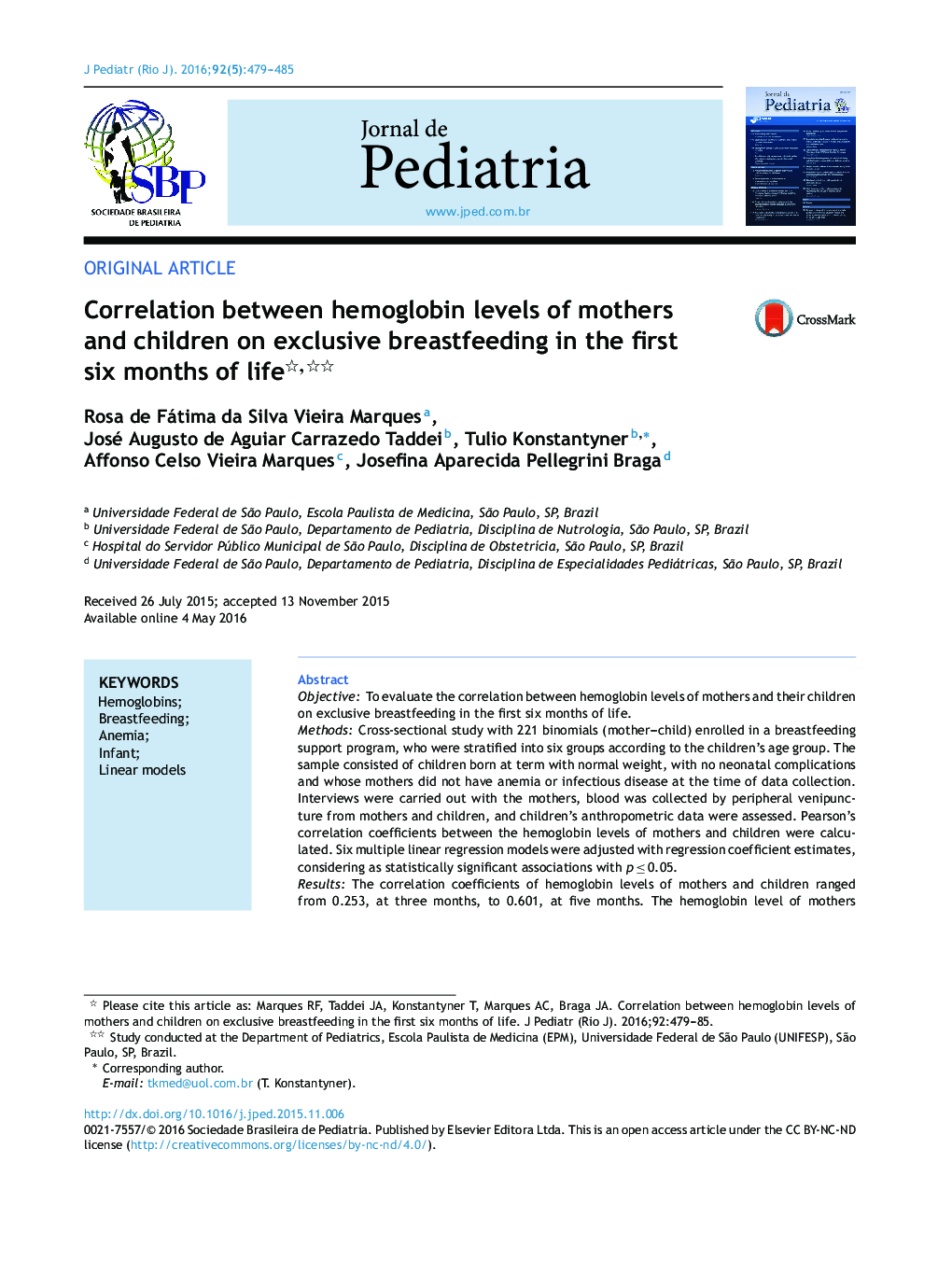| Article ID | Journal | Published Year | Pages | File Type |
|---|---|---|---|---|
| 4153753 | Jornal de Pediatria | 2016 | 7 Pages |
ObjectiveTo evaluate the correlation between hemoglobin levels of mothers and their children on exclusive breastfeeding in the first six months of life.MethodsCross-sectional study with 221 binomials (mother–child) enrolled in a breastfeeding support program, who were stratified into six groups according to the children's age group. The sample consisted of children born at term with normal weight, with no neonatal complications and whose mothers did not have anemia or infectious disease at the time of data collection. Interviews were carried out with the mothers, blood was collected by peripheral venipuncture from mothers and children, and children's anthropometric data were assessed. Pearson's correlation coefficients between the hemoglobin levels of mothers and children were calculated. Six multiple linear regression models were adjusted with regression coefficient estimates, considering as statistically significant associations with p ≤ 0.05.ResultsThe correlation coefficients of hemoglobin levels of mothers and children ranged from 0.253, at three months, to 0.601, at five months. The hemoglobin level of mothers was correlated with the hemoglobin level of their children at four months (r = 0.578) and at five months (r = 0.601). In the adjusted multiple linear regression, the regression coefficients were higher at four months (β = 1.134; p = 0.002) and at five months (β = 0.845; p < 0.001).ConclusionThese findings allow for the conclusion that there is a correlation between the hemoglobin of mothers and the hemoglobin of their children on exclusive breastfeeding in the first six months of life.
ResumoObjetivoAvaliar a correlação entre os níveis de hemoglobina de mães e de seus filhos em aleitamento materno exclusivo, no primeiro semestre de vida.MétodosEstudo transversal com 221 binômios (mãe-filho) matriculados em programa de incentivo ao aleitamento materno, que foram estratificados em seis grupos de acordo com a faixa etária das crianças. A amostra consistiu de crianças nascidas a termo, com peso normal, sem intercorrências neonatais e cujas mães não apresentavam doença infecciosa e anemia na época da coleta de dados. Foram realizadas entrevistas com as mães, coleta de sangue por punção de veia periférica das mães e das crianças e antropometria das crianças. Foram calculados os coeficientes de correlação de Pearson entre os níveis de hemoglobina das mães e das crianças. Foram ajustados seis modelos de regressão linear múltiplos com estimativas de coeficientes de regressão, considerando-se estatisticamente significantes associações com p≤0,05.ResultadosOs coeficientes de correlação dos níveis de hemoglobina das mães e das crianças variaram entre 0,253, aos três meses, e 0,601, aos cinco meses. O nível de hemoglobina das mães esteve mais correlacionado com o das crianças aos quatro meses (r = 0,578) e aos cinco meses (r = 0,601). Na regressão linear múltipla ajustada, os coeficientes de regressão foram maiores aos quatro meses (β = 1,134; p = 0,002) e aos cinco meses (β = 0,845; p < 0,001).ConclusãoEsses achados permitem concluir que há correlação entre a hemoglobina de mães e a hemoglobina de seus filhos em aleitamento materno exclusivo no primeiro semestre de vida.
